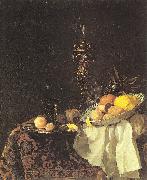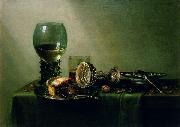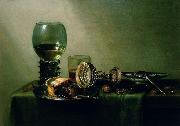Wholesale Oil Painting No Minimum |
|||||||||||
|
|
|||||||||||

|
|||||||||||
|
|
|
||||||||
Willem Kalf1619-1693 Dutch Willem Kalf Galleries Willem Kalf was born in Rotterdam, in 1619. He was previously thought to have been born in 1622, but H. E. van Gelder??s important archival research has established the painter??s correct place and date of birth. Kalf was born into a prosperous patrician family in Rotterdam, where his father, a cloth merchant, held municipal posts as well. In the late 1630s, Willem Kalf travelled to Paris and spent time in the circle of the Flemish artists in Saint-Germain-des-Pr??s, Paris. In Paris he painted mainly small-scale rustic interiors and still-lifes. Kalf??s rustic interiors are typically dominated by groups of vegetables, buckets, pots and pans, which he arranged as a still-life in the foreground (e.g. Kitchen Still-life, Dresden, Gemäldegal; Alte Meister). Figures usually appeared only in the blurred obscurity of the background. Though painted in Paris, those pictures belong to a pictorial tradition practised primarily in Flanders in the early 17th century, by such artists as David Teniers the Younger. The only indication of the French origin of the paintings are a few objects that Flemish exponents of the same genre would not have pictured in their works. Kalf??s rustic interiors had a large influence on French art in the circle of the Le Nain brothers. The semi-monochrome still-lifes which Kalf created in Paris form a link to the banketjes or 'little banquet pieces' painted by such Dutch artists as Pieter Claesz, Willem Claeszoon Heda and others in the 1630s. During the 1640s, Kalf further developed the banketje into a novel form of sumptuous and ornate still-life (known as pronkstilleven), depicting rich groupings of gold and silver vessels. Like other still-lifes of this period, these paintings were usually expressing vanitas allegories. |
||||||||
|
|
||||||||
Dessert
Dessert Painting ID:: 2108 |
1649
The Hermitage, St.Petersburg 1649 The Hermitage, St.Petersburg |
|||||||
|
|
||||||||
Willem Claesz. Hedapainted Dessert in 1637 |
||||||||
|
|
||||||||
|
|
Dessert
Dessert Painting ID:: 81674 |
Date 1637(1637)
Medium Oil on panel
Dimensions 44.5 x 69.5 cm (17.5 x 27.4 in)
Date 1637(1637) Medium Oil on panel Dimensions 44.5 x 69.5 cm (17.5 x 27.4 in) |
||||||
|
|
||||||||
Willem Claesz Heda1594-1682 Dutch Willem Claesz Heda Galleries Dutch painter. He was a still-life painter, who, like Pieter Claesz., is noted for his monochrome breakfast-pieces, which are, however, more opulent than those of Claesz. Heda earliest dated work is a Vanitas (1621; The Hague, Mus. Bredius), which shows a still-life from a high viewpoint, composed of various objects bearing vanitas associations (e.g. a bowl of glowing embers, smoker requisites, an overturned glass and a skull); the colouring is in brownish-grey tones and represents one of the earliest examples of a Dutch monochrome still-life (monochrome refers to the range of tones, rather than of colours). Even in this early work Heda skill at painting textures is evident. A more balanced composition is achieved in another Still-life (1629; The Hague, Mauritshuis) and in the Breakfast Table (1631; Dresden, Gemeldegal. Alte Meister), in both of which the objects, set against a neutral background, are linked by a strong diagonal. The Mauritshuis still-life also gives an early indication of Heda interest in painting the effects of light. In 1631 he became a member of the Haarlem Guild of St Luke (of which he served as deacon on several occasions after 1637). |
||||||||
|
|
||||||||
|
|
Dessert
Dessert Painting ID:: 85639 |
1637(1637)
Medium Oil on panel
Dimensions 44.5 x 69.5 cm (17.5 x 27.4 in)
cyf 1637(1637) Medium Oil on panel Dimensions 44.5 x 69.5 cm (17.5 x 27.4 in) cyf |
||||||
|
|
||||||||
|
Willem Claesz Heda 1594-1682 Dutch Willem Claesz Heda Galleries Dutch painter. He was a still-life painter, who, like Pieter Claesz., is noted for his monochrome breakfast-pieces, which are, however, more opulent than those of Claesz. Heda earliest dated work is a Vanitas (1621; The Hague, Mus. Bredius), which shows a still-life from a high viewpoint, composed of various objects bearing vanitas associations (e.g. a bowl of glowing embers, smoker requisites, an overturned glass and a skull); the colouring is in brownish-grey tones and represents one of the earliest examples of a Dutch monochrome still-life (monochrome refers to the range of tones, rather than of colours). Even in this early work Heda skill at painting textures is evident. A more balanced composition is achieved in another Still-life (1629; The Hague, Mauritshuis) and in the Breakfast Table (1631; Dresden, Gemeldegal. Alte Meister), in both of which the objects, set against a neutral background, are linked by a strong diagonal. The Mauritshuis still-life also gives an early indication of Heda interest in painting the effects of light. In 1631 he became a member of the Haarlem Guild of St Luke (of which he served as deacon on several occasions after 1637). Dessert 1637(1637) Medium Oil on panel Dimensions 44.5 x 69.5 cm (17.5 x 27.4 in) cyf |
||||||||
|
|
||||||||
|
Prev Next
|
||||||||
|
|
||||||||
|
Related Paintings to Willem Claesz Heda :. |
||||||||
|
|
||||||||
|
CONTACT US |



